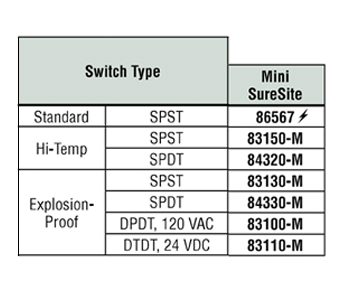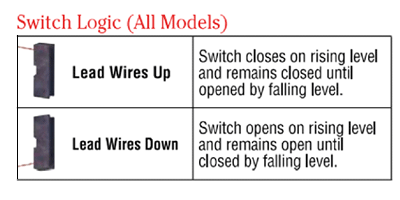How to Test a Mini SureSite Switch Module
The below information will help explain how to test a Switch Module on a Mini SureSite to verify it is working correctly. SureSite switch modules are clamped onto the housing so they can easily be removed, or the position adjusted.
First step is to identify what type of switch module you have. There is a Standard, High Temperature, and Explosion Proof versions. See below.
Below shows the p/n’s for the Mini SureSite Switch Modules.  After determining what type of switch module you have, take a picture of how it is positioned on the SureSite housing because this will determine the switches logic. The logic of the switch is determined based on the position of the lead wires/conduit connection. With the lead wires up the switch will close on rising level, which is typical for a High Alarm. With the lead wires down the switch will close on falling level, which is typical for a Low Alarm. See below diagram.
After determining what type of switch module you have, take a picture of how it is positioned on the SureSite housing because this will determine the switches logic. The logic of the switch is determined based on the position of the lead wires/conduit connection. With the lead wires up the switch will close on rising level, which is typical for a High Alarm. With the lead wires down the switch will close on falling level, which is typical for a Low Alarm. See below diagram.

One last step before removing the switch is to also note the orientation of the switch module. All switches must be 180 degrees (opposite side) from the flag assembly. See below diagram.
After you have determined the orientation and the logic of your switch is in, you can remove it from the housing by loosening the clamp. Switch modules work off reed switches, but they also have biasing magnets within them to make sure they remain in an open or closed state until the float and magnet return. Therefore, it is important to not use a strong magnet when testing your switch module. A strong magnet can damage the reed switch and/or biasing magnet.
If you have a spare float or can take the float out of your SureSite you may use that to test the switch module. If you can’t use a spare float, then you can use a small pencil magnet with a Gauss rating of around 1100 (+250 / -100). Ensure it is within that Gauss rating otherwise you risk damaging the switch module.
The reed switch will be located near the middle of the switches. See below for approximate location.
Take your float or small pencil magnet and run it along the back of the switch module. As the magnet comes within proximity to the reed switch it will actuate and change the state of the switch module. It’s important to note the state (Open or Closed) the switch module is in and the logic (Lead Wires Up or Down). For example, with the lead wires up and if you measure the switch to be open, you would then bring your magnet from the bottom up. This is because the switch is set up as a High Alarm switch, and since it’s open, the level of the liquid is beneath it, which is why you would bring the magnet from the bottom up. See below.
Below shows how to test it if the switch was lead wires down and open, which means it is used as a low-level alarm. Liquid is still above it since the switch is open and will close once the float/magnet travel beneath it.
Once you have determined your switch module is working correctly, you can next investigate whether your float has proper buoyancy and the magnet within the float is properly magnetized. Lastly before reinstalling your switch module back onto the housing, make sure it is in the correct logic. For example, if you’re using it as a high alarm, you want the lead wires up and you also want to make sure the switch is open (if the level is beneath the switch at the time of installation).
Refer to the Switch Modules Instruction Bulletin for further information.
 SEARCH OUR RESOURCE CENTER
SEARCH OUR RESOURCE CENTER
